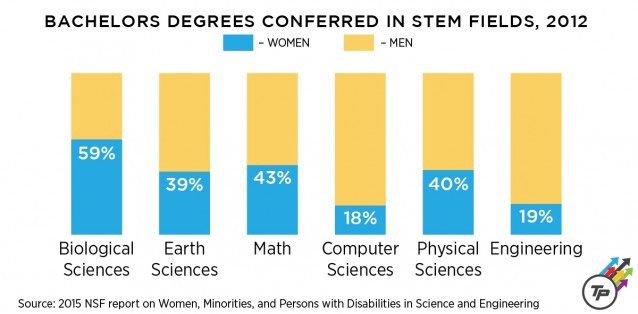There’s a growing mountain of evidence that women in the STEM fields face gender bias. This August, for example, female platform engineer Isis Wenger participated in an recruiting campaign — only to face ridicule based on her appearance and disbelief that she was actually an engineer. She then launched the #iLookLikeAnEngineer hashtag on Twitter, which went viral as women and minorities in STEM tweeted to combat stereotypes. And earlier in the summer, Nobel Prize-winning biochemist Tim Hunt made headlines when he said that the “trouble with girls” was that three things happen when they are let into the lab: “you fall in love with them, they fall in love with you, and when you criticize them they cry.”
These are egregious examples — but the empirical evidence backs them up. One landmark study found that science faculty at research universities rate applicants with male names as more competent, more hireable, and more deserving of a higher starting salary than female applicants, even when the resumes are otherwise identical.
.@IsisAnchalee could code aged 8 & also launched #ILookLikeAnEngineer after sexist comments http://t.co/G26rsDcGQ0 pic.twitter.com/uzv59dLcHm
— BBC News (World) (@BBCWorld) October 13, 2015
Now, a new study published by the Proceedings of the National Academy of Science (PNAS) shows another level of bias: Many men don’t believe this is happening.
When shown empirical evidence of gender bias against women in the STEM fields, men were far less likely to find the studies convincing or important, according to researchers from Montana State University (MSU), the University of North Florida, and Skidmore College.
In the first two parts of the experiment, participants were shown the real abstract of the resume-test study described above, along with the name of the journal that originally published it and its date of publication. They were then asked to evaluate their agreement with the authors’ interpretation, the importance of the research, and the quality of the abstract. This evaluation was carried out by both men and women from the general population, and also by male and female faculty from both STEM and non-STEM fields. The researchers then conducted statistical tests on the resulting data to see if there was a correlation between gender and perception of the abstract.
Men were significantly less receptive to the study abstract than women in both cases. Furthermore, in the case of faculty, there was a strong interaction between gender and field of study — meaning that male STEM professors were much less likely to believe the evidence of gender bias against women in their own field. Importantly, the researchers’ analysis showed that the cause of this statistical interaction was that male STEM professors were more likely to judge the research harshly, not that female STEM professors were more likely to view it positively.
In the second part of the study, men and women were shown one of two abstracts: one a real abstract finding evidence of gender bias in science fields, and another a slightly modified version of that abstract finding no gender bias. Women thought the study finding evidence of gender-bias was more persuasive, while men were unconvinced by this study and thought the modified study showing no gender bias was more reputable.
This follow-up study reveals a few crucial things. First, the results of the first study aren’t due to a general male tendency to be more critical, nor due to the particular abstract chosen. Second, there’s a bit of unconscious bias evident in both genders, as women were more persuaded by the abstract that confirmed their ideas about gender bias.
Given the prevalence of men in the sciences and the actual evidence of gender bias, however, men’s unconscious bias proves to be more insidious.

Although the gap is shrinking, women are still underrepresented in the sciences. According to data from the National Science Foundation, while women earned 57 percent of bachelors degrees in all fields in 2012 and over half of the degrees awarded in the biological sciences, they receive far fewer in other STEM degrees: 39 percent of degrees in Earth sciences, 43 percent of degrees in mathematics and statistics, 19 percent of degrees in engineering, and 18 percent of degrees in computer science. Women are also underrepresented outside the academy: While women make up over 58 percent of those working in social sciences and 48 percent of those in biological sciences, they still make up only 13 percent of those in engineering and 25 percent of those in computer science and math.
The result is that men dominate the STEM fields throughout industry and academia. The only way to change that is to confront the reality of the disparity and the reasons behind it, of which gender bias is undoubtedly a contributing factor. Unconscious bias can keep women in the STEM field from jobs, fair salaries, and mentorship opportunities — and a persistent feeling of being undervalued could push them out of their laboratories or nudge them into a different field altogether.
The only way to fix a problem is to first admit that you have one. But the new PNAS study shows that the male-dominated scientific community is unlikely to do that, even when they’re confronted with hard evidence.
As the study’s authors write: “How can we successfully broaden the participation of women in STEM when the very research underscoring the need for this initiative is less valued by the majority group who dominate and maintain the culture of STEM?”
